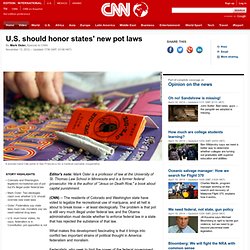

Pa. museum tells blind visitors: Please touch! Nov. 25, 2013: Angel Ayala, left, and Austin Seraphin touch a quartzite likeness of Ramesses II at the Penn Museum in Philadelphia.AP Photo/Jacqueline Larma Nov. 25, 2013.: Katie Maunder, left, reaches out to touch a replica of a mummy as blind high school student Angel Ayala, 16, center, visually impaired high school student Tatyana Allen, 16, right and blind high school student Cache Ballard, 16, participate in the classroom segment of a special tour at the Penn Museum in Philadelphia.AP Photo/Jacqueline Larma Nov. 25, 2013: Angel Ayala touches a replica of a vessel during the classroom segment of a special tour at the Penn Museum in Philadelphia.

Ayala, 16, has been blind since birth.AP Photo/Jacqueline Larma PHILADELPHIA – Angel Ayala has never been a big fan of museums. Blind since birth, the high school student says the exhibits are so sight-dependent that he can't enjoy them. Ask a science teacher: What makes ice float? The simple answer is that ice is less dense than water.

The question then becomes: Why is ice, which is water in solid form, lighter than water in its liquid form? Something must be happening to water when it freezes. One molecule of water has two hydrogen atoms and one oxygen atom, or H2O. The hydrogen atom is slightly positive, and the oxygen atom is slightly negative. At room temperature, these water molecules are loosely linked and free to move around easily, which is what defines the liquid state of matter. Once the temperature hits 32°F, or 0°C, the molecules line up in a rigid six-sided honeycomb structure, with water molecules—the more positively charged hydrogen attracting the more positively charged hydrogen—linking up with each other in a process called hydrogen bonding. This causes the molecules to move more slowly and take up more space. We can put salt on ice to melt it. A water molecule has one atom of oxygen bound to two atoms of hydrogen. What happens to the ice cube? Marijuana and Federalism. A woman hand rolls joints in San Francisco for a medical cannabis cooperative.

Colorado and Washington legalized recreational use of pot but it's illegal under federal lawMark Osler: Two ideologies clash over whether U.S. should override new state lawsOsler: Federalists say state laws must rule; moralists say we need national drug lawsU.S. must honor states, he says; federalism is in Constitution, pot opposition is not Editor's note: Mark Osler is a professor of law at the University of St. Thomas Law School in Minnesota and is a former federal prosecutor. He is the author of "Jesus on Death Row," a book about capital punishment. (CNN) -- The residents of Colorado and Washington state have voted to legalize the recreational use of marijuana, and all hell is about to break loose -- at least ideologically. What makes this development fascinating is that it brings into conflict two important strains of political thought in America: federalism and moralism.
Mark Osler. Seven states qualify for secession response from White House. The petitions for secession from the U.S. filed by Texas, Louisiana, and five other states have collected more than 25,000 signatures each, which the White House website says is enough for review and response.

WASHINGTON - Citizens from more than 40 states have filed petitions with the White House seeking to secede from the union, and by Wednesday, seven states had gathered enough signatures to qualify for a response to the largely symbolic protest. The petitions, which have been signed by a small percentage of state residents, have virtually no chance of succeeding. The United States' bloodiest conflict, the 1861-1865 Civil War, erupted after 11 states withdrew from the union. The White House has set up a "We the People" page on its website that allows Americans to file petitions on issues of concern.
If a petition collects 25,000 signatures, the website says, the administration will review and respond to it. Sign language interpreter for Mandela memorial says he was hallucinating, often becomes 'violent' A man being criticized by sign language experts for providing fake interpretations while standing close to President Obama and other heads of state at Nelson Mandela’s memorial says he becomes violent “a lot” and was hallucinating during the event.

Thamsanqa Jantjie did not describe his qualifications for being a sign language interpreter, but told The Star he works for an interpreting company that paid him $85 for working Tuesday's event, according to The Associated Press. He told Radio 702 on Thursday he's receiving treatment for schizophrenia and had an episode while on stage at FNB Stadium in Johannesburg. "What happened that day, I see angels come to the stadium ... I start realizing that the problem is here.
And the problem, I don't know the attack of this problem, how will it come. "I was in a very difficult position," he added. Asked how often he had become violent, he told The Associated Press "a lot," while declining to provide details. "There was zero percent accuracy.